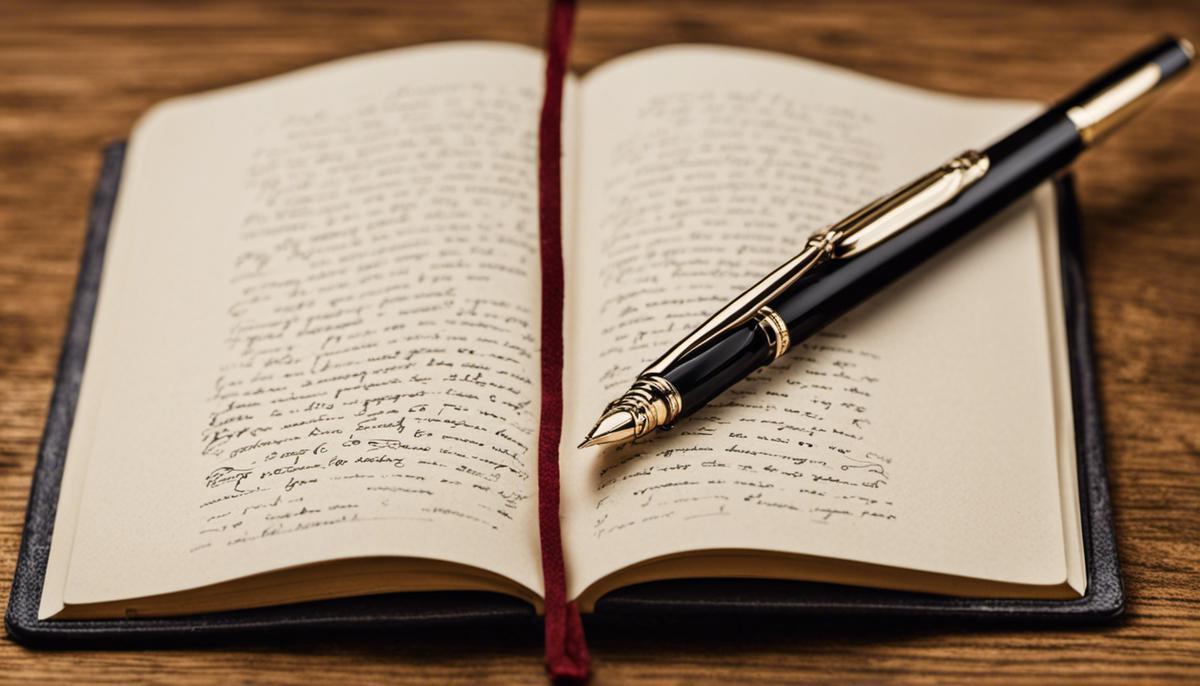The beauty of language and the power of expression find the epitome of artistic fusion in the realm of poetry. As both an art and a form of communication, it offers a vibrant channel to express emotions, ideas, and illustrations using rhythm, rhyme, structure, and a palette of metaphoric language. This exploration into the fascinating world of poetry not only evokes our understanding of various types of poems—from sonnets and haikus to limericks and free verse—but also embarks on an expansive journey where through descriptive language, one learns to create vivid imagery, stirring sensory experiences and profound emotional responses within the reader.
Table of Contents
Understanding the basics of poetry
Unraveling the Essential Elements of a Poem: A Dive into Poetic Structure.
Oh, the beautiful world of poetry! A realm where words are not just mere words, but rhythmical expressions of emotion, introspection, philosophy, and stories of life and beyond. These sophisticated verses are strung together with not only rhyme and meter, but several other essential elements that lend beauty and depth to a poem. Let’s unravel these poetic fundamentals for fellow poetry enthusiasts who wish to explore the intricate structure of this compelling art form.
- Structure: A quintessential scaffolding of a poem
Every masterpiece of a building starts with a structured blueprint and so does a poem. A poem’s structure is not always apparent, but approaching it with attention brings rewards. On the surface level, the structure relates to the physical layout – the lines, stanza breaks, and the spacing between words. But wait, there’s more to it. Delve deeper, and you’ll discover structures like sonnets, haikus, or free verse. A quick tip for explorers of poetry structure: assess the number of lines, the stanza pattern, and if a particular structure repeats throughout the poem or changes dynamically.
- Rhythm: The pulsating heartbeat of a poem
Imagine a poem as a living entity; rhythm then would be its heartbeat. The rhythm paces the read, providing energy, emphasis, and even emotional tone. It’s the pattern of stressed and unstressed syllables. To identify rhythm, tap it out; hear the ‘beat’ as you read the lines aloud. Diverse rhythm types like Iambic, Trochaic, or Spondaic, each add their unique flavor to a poem.
- Rhyme: Interlacing the melody within poetry
Rhyme is the consonance between the end syllables of verses, creating a melodic flow. Not every poem rhymes, but when skillfully applied, rhyme can enrich the musical harmony of a poem and reinforce its theme. Rhymes can be versatile, ranging from the traditional end rhymes, eye rhymes to within-line and near rhymes.
- Imagery: Painting vivid pictures with words
What makes a poem come alive, transporting readers to its realm? It’s the magic of imagery that entails using concrete descriptions and sensory details to evoke vibrant mental pictures. Keep in mind that a poem not just appeals to sight, but it can invoke all five senses, creating a multi-dimensional experience.
- Theme: The central idea or message
What’s a poem without its soul, its essence? That’s where the theme steps in. It can be a potent single word like ‘love’ or ‘death,’ or complex ideas like the passage of time or the human condition. A rewarding exploration of a poem often involves unearthing these underlying themes.
- Language and Diction: Choosing words with precision
In poetry, every word counts. Remember, words in a poem do not only convey direct meanings but also carry connotations, associations, and emotional overtones. The language and diction in poetry add to its depth, richness, and subtlety, making it a rewarding journey for poetry enthusiasts and literary critics alike.
- Tone: Reflecting the poet’s attitude
Just like in conversation, the tone in poetry is crucial. It reflects the poet’s attitude towards the poem’s speaker, subject matter, or the audience. Grasp the tonal shifts, and you’ll unravel a new layer to the poem’s narrative.
Unraveling these poetic fundamentals is just a starting point. Poetry is a vast ocean waiting to be explored with every reading, unveiling its depth and beauty, layer by layer. And as you dive deeper into this enchanting world, remember, as Robert Frost once said, “Poetry is when an emotion has found its thought and the thought has found words.” Happy exploring!

Creating vivid imagery
“Crafting Vivid Imagery in Poetry: Techniques and Tricks for Breathtaking Verse”
Unfolding the splendor of a sunset, echoing melancholy through leaves falling in autumn, or shaping the taste of sorrow in a single teardrop – it’s the beguiling world of imagery, the poetry’s supreme tool to create visceral, sensory experiences. But how can an aspiring poet master this art of illustrating vivid images? Let’s dive straight into it!
Pioneering poets believe that sensory penmanship is the cornerstone of evocative imagery. Generating a connection between words and sensory perceptions could result in enchanting images that give your poetry life and texture. Reflect upon the triggers for each of your senses: use a petrichor to evoke the smell of rain, describe the silence as being as thick as velvet, or compare heartache to an icy winter chill. It’s all about knowing how to trigger a reader by fusing everyday experiences with sensory perception.
Metaphors and similes work like magic wands when creating riveting visuals in poetry. An extended metaphor that threads its way through your stanzas can set a stage for your readers. Similes, on the other hand, build an immediate bridge between the unfamiliar and the familiar, aiding readers in visualizing your verse. Remember, the key lies in striking a balance; judicious use of these tools can elevate your poem’s imagery without making it appear contrived.
Connotation, the emotional or cultural associations that words bear beyond their dictionary definition, is another excellent tool for developing vivid imagery. Dark connotations can shroud your poem in esoteric mystery, while tepid words help it breathe serenity and peace. Harness this feature of language to convey depth and add layers to your images.
Consider exploring symbolism to imbue your poetry with profound imagery. Whether it’s the symbolic use of objects, colors, or natural elements, these coded meanings can add a wealth of resonance to your work. For example, a simple rose can symbolize love, mystery, or even a painful secret.
Last but not least, and perhaps the most important, is to experience, observe, and continually feed your imagination. An insightful poet draws from a well of personal experiences and a reservoir of observation. The more you observe, the greater your understanding of the world and your potential to bring its elements to life.
Writing poetry that scintillates with vivid imagery won’t happen overnight. Just like rolling waves carve the shore, it’s a process that takes time, patience, and meticulous attention to detail. But trust, with such an approach, the journey to creating emotive and soul-stirring imagery will be as rewarding as the poetic masterpiece that emerges at the end.

Expressing emotions and ideas
Subject Matter: Sailing in the Deep Ocean of Emotions
In the vast sea of poetic expressions, emotions serve as the secret treasure chest buried beneath the profoundness of words. Efficient communication of emotions in poetry lays the groundwork for the formation of a heartfelt connection with the reader. To untap this treasure chest of emotions, dive deep, and swim around in the language of the soul.
To effectively communicate emotions in a poem, it is instrumental to understand the power of ‘show, don’t tell.’ Rather than explicitly stating the emotion the character feels, the clever aspect of poetry permits the setting up of a scenario that signifies these feelings. Dedicate ink to describing the sweaty palms, shaky hands, lump in the throat, racing heartbeat, instead of merely saying ‘the character was scared.’ This astral projection of real emotions provides a leap into the depths of character’s feelings, allowing readers to connect instantly.
The next stroke of the brush brings us to the practice of utilizing personal experiences. An efficient poet wraps their emotional spectrum around their sleeve, serving it beautifully on the canvas of words. They draw emotions from their personal narratives, experiences, and memories, thereby enhancing their capacity to add authenticity to the poem.
One of the eternal keys to communicating emotions effectively revolves around avoiding clichés. These worn-out phrases may dull the lustre of an otherwise edge-of-the-seat, poignant poem. Seeking original, fresh substitutes to these trite expressions enables poets to sustain the reader’s interest and offer them a taste of true emotions.
Ever wondered what makes poems like ‘The Raven’ and ‘Stopping by Woods on a Snowy Evening’ so notable? It’s their almost magical ability to leave the readers pondering and interpreting. Engaging the reader in the process of processing emotions through open-ended language adds a layer of intrigue. This subtlety pushes the readers to step into the shoes of the character, makes them mull over the emotions, find personal connections, thereof adding essence to the poetic experience.
Equally paramount is to remain true to the emotion throughout the poem and maintain emotional consistency. Abrupt shifts in emotions can often confuse the reader, causing them to lose contact with the core sentiment. Harmonization of feelings and integrating them smoothly across the poem enhances the overall emotional impact. However, always remember that gradual progression in emotions amplifies the dramatic effect.
Ultimately, the greatest gift poetry offers is the freedom to express emotions in their raw, intense forms. An effective poet embraces the juxtapositions, celebrates the contrasts and lets emotions take the lead. The dance of words allow shades of joy, sorrow, love, envy, fear, and countless emotions to come alive on the bare stage of a blank page.
Playing the silent notes of emotions on the grand piano of poetry demands a touch of honesty, vulnerability, creativity and close observation. Clad in the coat of such elements, your poem becomes a mirror reflecting the true emotional beauty lying undiscovered beneath the depth of the heart. Evermore, through the lenses of universal emotions, your poetry flashes colors of genuine sentiments, etching everlasting impacts in the hearts of readers.
Remember, a poem layered with emotions doesn’t merely exist, it lives and breathes with the pulsating rhythm of a heart full of unspoken feelings, experiences, and memories. It weaves an undeniable connection, becoming a silent whisper in the ears of the heart. Poet or not, isn’t that what we all aim for? To feel, to connect and be understood, in this messy, beautiful world of ours.

Photo by ageing_better on Unsplash
As we wind down this poetic journey, we reflect on the power of words and comprehend that this ability to express our deepest emotions, perceptions and thoughts is not a mere skill, but an intimate dialogue with our own self and with the world. Through the understanding and application of various poetic techniques like symbolism and metaphor, poetry becomes more than an art form—it transforms into a mirror revealing our inner world. Mastering the poetic craft requires patience, perseverance, and passion, but its rewards are immeasurable as it enables us to clothe our ideas and emotions in words and share our unique perspective with the world.

Zara Desertrose is an acclaimed fashion and lifestyle journalist with a Master’s in Fashion and Luxury Marketing. Known for her keen eye for style and cultural trends, Zara’s writing elegantly weaves together the latest fashion movements with lifestyle aesthetics. Her insightful critiques and trend forecasts make her a leading voice for anyone looking to stay at the vanguard of style.

